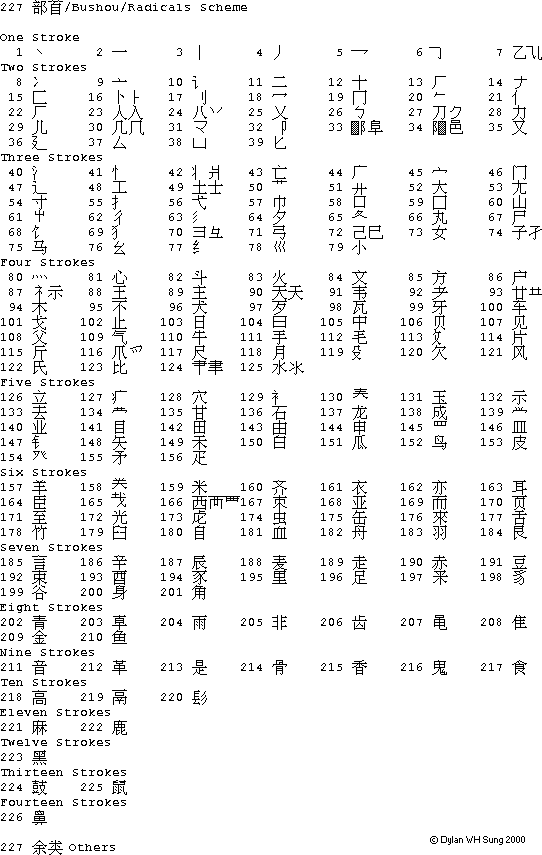
Problem that have arisen with Simplification
The first national standard for simplified characters in China was published in 1956. Prior to this milestone, some characters had several variant forms which were either similar in complexity, or having fewer penstrokes. The new simplified hanzi was to officially replace all previous variants of the complex character in all government publications.
Simplfied Character Classification
The 214 KangXi Radicals of the KangXi Dictionary provided the most widely found standard of character classification of hanzi. It encompassed many variant forms, and at the time of its first publication, the most authoritative work to date and the index system was even adopted outside China. As many of the variant forms which later became standard simplified hanzi could also be found in the KangXi Dictionary, it would have been one argument that it could encompass all simplified hanzi.
However, when more and more characters were simplified, loosing their original complex character's radical in the body of the simplified character and the creation of totally new characters, the 214 KangXi index is not best suited to the new characters. So, the simplified characters required their own new classification system. As with the spirit of the modernisation of the written language, a revision of the radicals system was made. In fact several schemes exist for simplified characters.
Modern mainland dictionaries have created numerous sets of simplified radical indexes. These provide the user with the challenge that the character they have located in one dictionary under one particular radical, is found under another radical in a new dictionary.
The characters that can be found under one radical in the KangXi Dictionary now became scattered under several new simplfied character radicals index. The following scheme contains 227 radicals.

Note that the simplified radicals 10 讠 and 147 钅 exist side by side with the complex radicals 185 言 and 209 金 in the same scheme. Under this 227 simplified radicals scheme, the character 肉 is classified under the radical numbered 19 冂. The characters which were onced grouped under the 'flesh' radical 肉 are now mostly found under radical numbered 118 月 'moon', and the character 肩 'shoulder' is classified under the radical 86 户 'door'.
The category 227 余类 or 'others' contain characters which do not fit into the other 226 radical categories. These include the characters 乡, 屯, 巴, 东, 民, 凸, 凹, 卵, 举 and 叛
Of these, the characters 乡, 东, and 举 are simplified forms. The rest are bone-fide traditionally used characters that are categoried under the 214 radicals system.
Oddities
幹 gan4 干
乾 gan1 干
乾 qian2
The complex characters 幹 and 乾 are both simplified to 干. However, the character 乾 has a second reading, qian2 which is used in the geomancy term 乾坤 qian2kun1 'heaven and earth'. The character 干 cannot be used in this case for the reading 'qian2'.
睾
The character gao1 睾 used in the compound 睾丸 gao1wan2 'testis, testicle' cannot be simplfied even though characters such as 澤驛籜 are simplified to 泽驿箨 which contain the same component.
Unicode
All the characters given in these pages are encoded in the decimal format of Unicode. Unicode itself uses the 214 Kangxi radicals to encode Chinese characters from different locales. This include the simpflied forms, and traditional characters and their variants. The placement of the characters within the Unicode standard is discussed in the Unicode Site and its paper publication.
In searching for the characters whilst writing these pages, one finds that there are often not so obvious use of the 214 radicals to accomodate the simplfied hanzi. That all the simplified characters found in the Guo Biao standard can be found in Unicode shows that it is possible to accomodate the new characters in the old four hundred year old indexing scheme, albeit, somewhat puzzling assignments at times.
This is somewhat unsatifactory since the location of the simplfied characters is not always automatic. The simplified hanzi found in the 'others' category of the 227 radical scheme are located under Kangxi radicals 乙, 一 and 丶 respectively.
Summary
The simplfications have brought about some difficulties in classification of simplfied hanzi. The varying numbers of schemes for classification of hanzi characters may lead to confusion as to which radical is the appropriate radical under which a common character is located.
Some character components which have simplified forms may not be used under certain circumstances.
However, despite the difficulties that arise when trying to categorise the newly created simplifications, it is possible to accomodate those characters with the framework of the 214 radicals system as show by the Unicode standard. This is tempered by location of simplified characters under radicals different to traditional form, under the more recognised KangXi Radicals.
To tie up the loose ends, the obsolete simplified hanzi from Singapore are presented.
This page was created on Thursday 22nd February 2001
and last updated on Monday 26th February 2001.